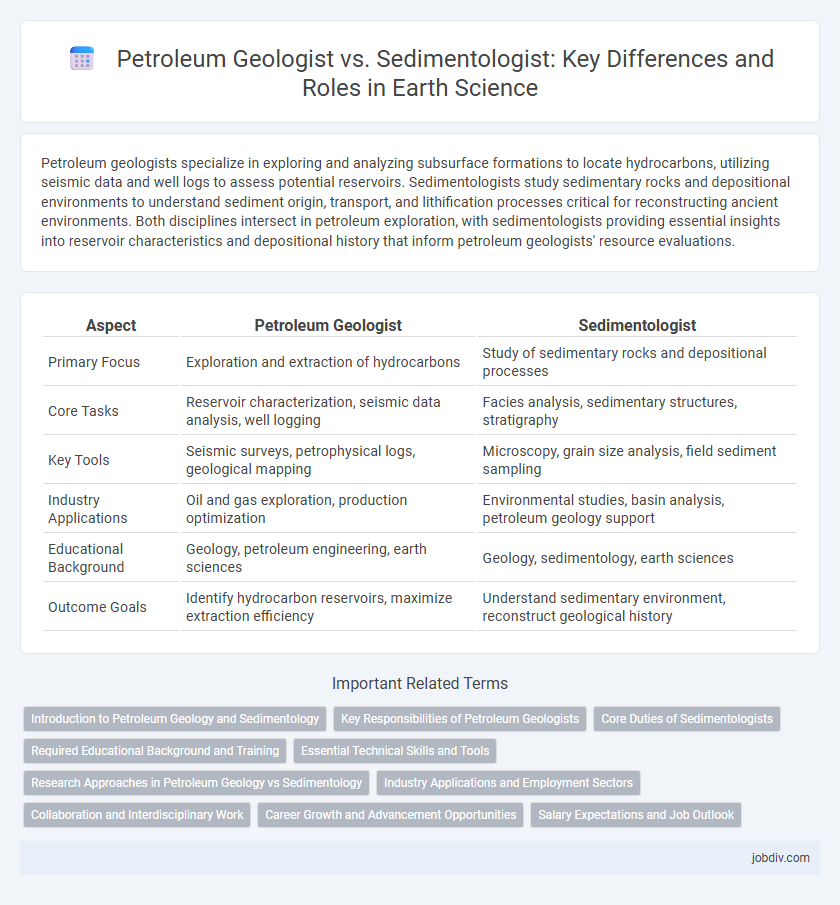Petroleum geologists specialize in exploring and analyzing subsurface formations to locate hydrocarbons, utilizing seismic data and well logs to assess potential reservoirs. Sedimentologists study sedimentary rocks and depositional environments to understand sediment origin, transport, and lithification processes critical for reconstructing ancient environments. Both disciplines intersect in petroleum exploration, with sedimentologists providing essential insights into reservoir characteristics and depositional history that inform petroleum geologists' resource evaluations.
Table of Comparison
| Aspect | Petroleum Geologist | Sedimentologist |
|---|---|---|
| Primary Focus | Exploration and extraction of hydrocarbons | Study of sedimentary rocks and depositional processes |
| Core Tasks | Reservoir characterization, seismic data analysis, well logging | Facies analysis, sedimentary structures, stratigraphy |
| Key Tools | Seismic surveys, petrophysical logs, geological mapping | Microscopy, grain size analysis, field sediment sampling |
| Industry Applications | Oil and gas exploration, production optimization | Environmental studies, basin analysis, petroleum geology support |
| Educational Background | Geology, petroleum engineering, earth sciences | Geology, sedimentology, earth sciences |
| Outcome Goals | Identify hydrocarbon reservoirs, maximize extraction efficiency | Understand sedimentary environment, reconstruct geological history |
Introduction to Petroleum Geology and Sedimentology
Petroleum geologists specialize in identifying and evaluating subsurface formations for hydrocarbon exploration by analyzing geological structures and rock properties, whereas sedimentologists focus on understanding sedimentary processes, sediment characteristics, and depositional environments that influence reservoir quality. An introduction to petroleum geology involves studying basin analysis, structural geology, and petrophysics, while sedimentology emphasizes sediment grain size, sorting, stratification, and diagenesis to interpret past environments. Both disciplines integrate seismic data, core samples, and well logs to optimize exploration and production strategies in oil and gas industries.
Key Responsibilities of Petroleum Geologists
Petroleum geologists specialize in identifying and evaluating subsurface rock formations to locate and quantify hydrocarbon reservoirs using seismic data interpretation and well log analysis. Their key responsibilities include assessing reservoir quality, estimating hydrocarbon volume, and guiding drilling operations to optimize extraction efficiency. Expertise in structural geology, stratigraphy, and geophysical methods is critical for accurate subsurface mapping and resource evaluation.
Core Duties of Sedimentologists
Sedimentologists analyze sediment composition, depositional environments, and stratigraphic sequences to interpret Earth's geological history and predict reservoir quality. They focus on sediment transport processes, grain size distribution, and sedimentary structures essential for reconstructing paleoenvironments and aiding hydrocarbon exploration. Core duties include field sampling, petrographic analysis, and integrating sedimentological data with geophysical information to enhance subsurface models.
Required Educational Background and Training
Petroleum geologists typically require a bachelor's degree in geology or earth sciences, often complemented by specialized training in petroleum geology, reservoir characterization, and seismic interpretation. Sedimentologists usually hold degrees in geology or earth science with a strong emphasis on sedimentology, stratigraphy, and depositional environments, often pursuing advanced coursework or research related to sedimentary processes. Both professions benefit from field experience, internships, and knowledge of geospatial analysis and petrographic techniques to enhance their expertise in subsurface exploration and sediment analysis.
Essential Technical Skills and Tools
Petroleum geologists utilize seismic interpretation software, well log analysis, and subsurface mapping tools to identify hydrocarbon reservoirs and evaluate their potential. Sedimentologists employ grain size analysis, petrographic microscopes, and sedimentary facies modeling to interpret depositional environments and sediment transport processes. Both disciplines require proficiency in GIS and core sampling techniques to enhance subsurface data accuracy and stratigraphic correlation.
Research Approaches in Petroleum Geology vs Sedimentology
Petroleum geologists employ seismic data interpretation, subsurface mapping, and reservoir characterization techniques to identify hydrocarbon accumulations and assess potential drill sites. Sedimentologists focus on sedimentary rock analysis, depositional environment reconstruction, and stratigraphic framework development to understand sediment transport and deposition processes. Integrating geophysical data with sedimentological models enhances the accuracy of petroleum system evaluations and reservoir predictions.
Industry Applications and Employment Sectors
Petroleum geologists primarily work in the oil and gas industry, focusing on locating and evaluating hydrocarbon reservoirs to optimize exploration and production efforts. Sedimentologists contribute to energy, environmental consulting, and mining sectors by studying sedimentary processes and rock formations to predict and mitigate geological hazards. Both professions offer career opportunities in government agencies, research institutions, and private companies specializing in natural resource management and environmental assessment.
Collaboration and Interdisciplinary Work
Petroleum geologists and sedimentologists collaborate closely to interpret subsurface data, combining expertise in rock properties and sedimentary environments to enhance hydrocarbon exploration accuracy. Their interdisciplinary work integrates seismic analysis, stratigraphy, and depositional models, enabling more precise reservoir characterization and risk assessment. This partnership improves exploration efficiency and optimizes resource extraction by leveraging complementary geological insights.
Career Growth and Advancement Opportunities
Petroleum geologists often experience rapid career growth through roles in exploration, reservoir characterization, and production management within the energy sector. Sedimentologists advance by specializing in sedimentary processes, environmental consulting, and academic research, which may lead to leadership positions in geology or environmental firms. Both fields offer opportunities for progression, but petroleum geology typically provides higher earning potential and faster advancement due to industry demand and project scale.
Salary Expectations and Job Outlook
Petroleum geologists generally command higher salaries, with median annual earnings around $105,000, driven by the energy sector's demand for hydrocarbon exploration expertise. Sedimentologists, focusing on sedimentary processes and rock formations, earn slightly less, averaging between $65,000 and $85,000, reflecting broader applications in environmental consulting and academia. Job outlook for petroleum geologists is closely tied to oil price volatility and exploration budgets, while sedimentologists benefit from more stable demand linked to environmental assessment and climate change research.
Petroleum Geologist vs Sedimentologist Infographic

 jobdiv.com
jobdiv.com